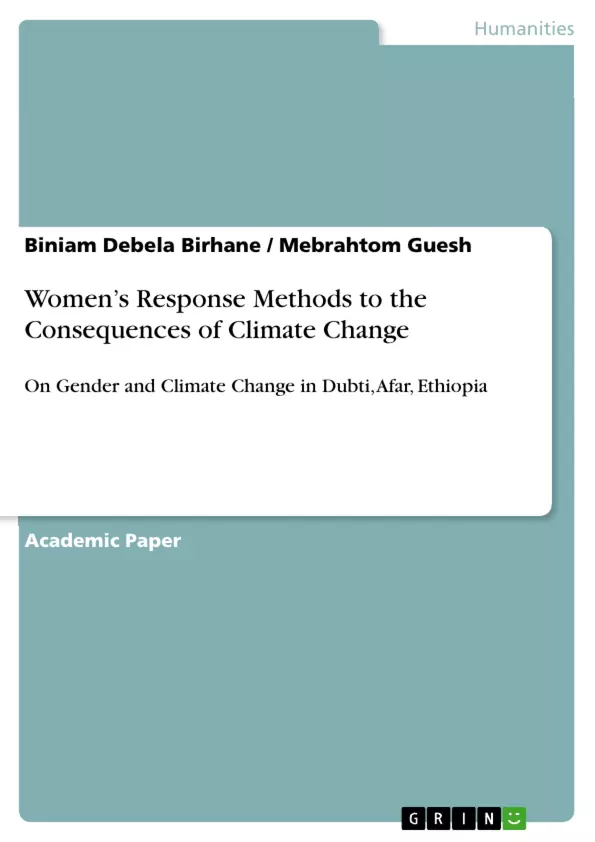The present study focuses on the relationship between gender and climate change in Ethiopia. The majority of Ethiopian women are largely engaged in the agricultural sector, which is highly vulnerable to climate changes. This study aims at analyzing the determinants of women’s response measures of climate change in the Dubti Woreda. This article designes as cross-sectional research design and employs qualitative and quantitative research approaches. Data is obtained from primary and secondary sources. Moreover, both the probability and nonprobability sampling techniques are employed.
The result from the binary logistic model reveals that age, access to training, farming experience, access to credit service, radio and mobile services determines women’s response methods to the consequence of climate changes. Finally, the article recommends for greater investment in women education and training to address the above-mentioned challenges. The impact of climate change is increasing from time to time. Climate change causes for floods, droughts, cyclones and desertification processes and this put the population of the world, especially developing countries at high risk and can undermine the development efforts to reduce poverty. The poor are the most vulnerable to climate change and women are among the greatest number share of the poor, because women constitute more than 70% of the overall worldwide population living below the poverty line, and this implies how many women are more vulnerable to the effects of climate change compared to other groups.
Climate change has gender-specific implications in terms of response and there are structural differences between men and women through, for example, gender-specific roles in society, work and domestic life. Response strategies are uneven across and within societies. In relation to this, there are individuals and groups within all societies that have an insufficient decision to response of climate change, for example, in most African countries women in subsistence farming communities are disproportionately burdened with the costs of recovery and coping with drought. Furthermore, women in Sub-Saharan Africa have lower levels of education; they have smaller farms, less access to markets, credit and other inputs which also might be a factor limiting their response strategies to the consequence of climate change.
Inhaltsverzeichnis (Table of Contents)
- Abstract
- Introduction
- Background of the Study
- Statement of the Problem
- Research Methodology
- Description of the Study Area
- Research Design
- Research Approach
- Data Types and Sources
- Sampling Techniques
Zielsetzung und Themenschwerpunkte (Objectives and Key Themes)
This research aims to analyze the factors that influence women's response strategies to the consequences of climate change in the Dubti Woreda of Ethiopia. The study examines the existing response strategies employed by women and seeks to understand the determinants of their decision-making processes.
- Women's responses to climate change in rural Ethiopia
- The impact of climate change on women's livelihoods
- Determinants of women's decision-making regarding climate change response strategies
- Gendered vulnerability to climate change and the need for gender-sensitive solutions
- The role of education, access to resources, and social networks in influencing women's responses
Zusammenfassung der Kapitel (Chapter Summaries)
- Introduction: The introductory chapter sets the stage for the research by discussing the escalating impact of climate change on vulnerable populations, particularly women in developing countries. It highlights the disproportionate burden of climate change on women due to their economic and social roles. The chapter emphasizes the need for research to understand the factors influencing women's response strategies and to inform the development of gender-sensitive climate change adaptation measures.
- Research Methodology: This chapter provides a detailed overview of the study's design and methodology. It describes the study area, Dubti Woreda in the Afar Region of Ethiopia, and its socio-economic characteristics. The chapter outlines the research design, approach, data sources, and sampling techniques employed in the study. It also discusses the rationale for using a cross-sectional survey design and the integration of qualitative and quantitative research methods to gain a comprehensive understanding of women's experiences and perspectives.
Schlüsselwörter (Keywords)
The study focuses on the crucial themes of climate change, women's response strategies, and the interplay of gender, social, and economic factors influencing their decision-making. It investigates the determinants of women's responses to climate change in the Dubti Woreda, drawing on concepts such as vulnerability, adaptation, and resilience. The research employs a binary logistic regression model to analyze the relationship between specific factors and women's response methods.
- Citation du texte
- Biniam Debela Birhane (Auteur), Mebrahtom Guesh (Auteur), 2018, Women’s Response Methods to the Consequences of Climate Change, Munich, GRIN Verlag, https://www.grin.com/document/455338



